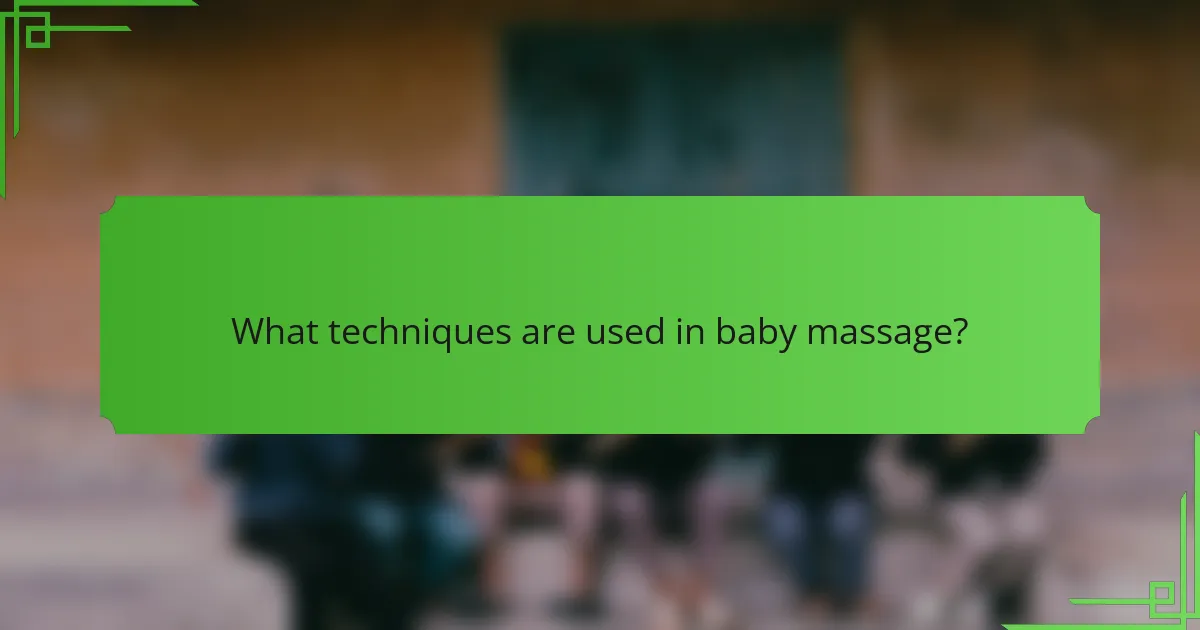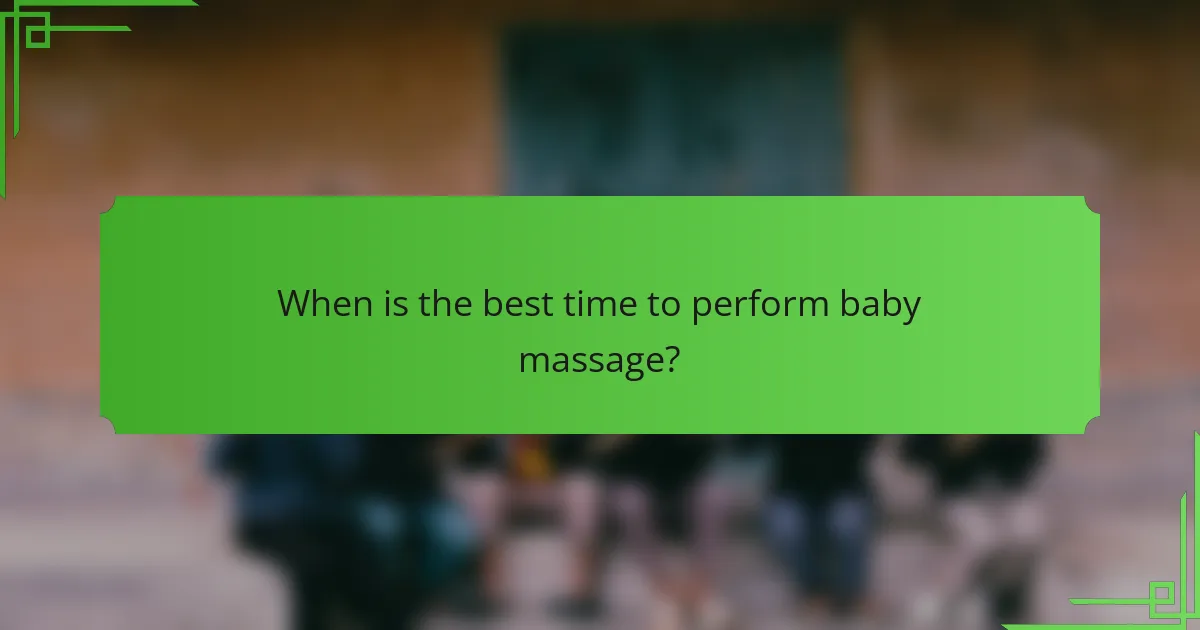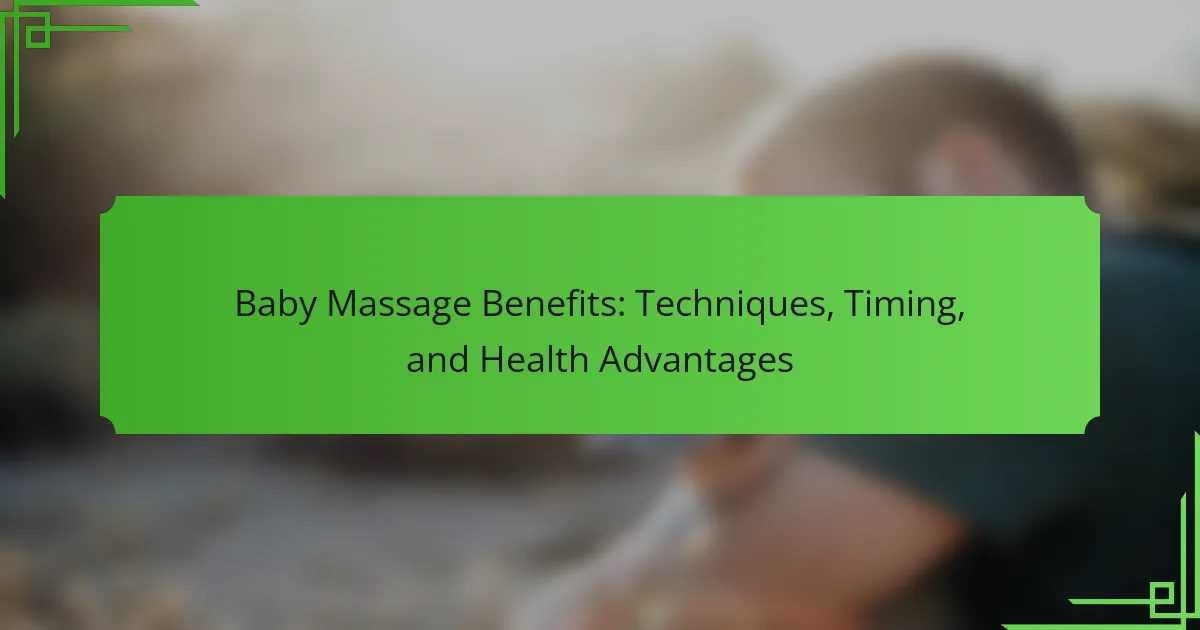Baby massage is a practice that offers significant benefits for both infants and caregivers. It promotes better sleep patterns, enhances emotional bonding, alleviates colic symptoms, and supports digestive health. Various techniques, including effleurage, petrissage, friction, and tapotement, are used to facilitate these benefits. The optimal times for performing baby massage are after a bath or before bedtime, which can help establish a calming routine and improve sleep quality. Research indicates that regular massage can lead to increased weight gain and overall well-being in infants.

What are the benefits of baby massage?
Baby massage provides numerous benefits for infants and caregivers. It promotes better sleep patterns in babies. Studies show that infants receiving massage sleep longer and more soundly. Baby massage enhances parent-child bonding through physical touch. This connection fosters emotional security and trust. It can also alleviate colic symptoms and reduce crying. Research indicates that massage can improve digestive health in infants. Additionally, baby massage may boost immune function. A study published in the Journal of Pediatrics found that massage therapy in infants led to increased weight gain. Overall, baby massage supports both physical and emotional well-being.
How does baby massage promote physical development?
Baby massage promotes physical development by enhancing muscle tone and coordination. The gentle pressure applied during massage stimulates blood circulation. Improved circulation aids in nutrient delivery to developing muscles. This process supports the growth of healthy tissues and muscles. Additionally, massage encourages joint flexibility and range of motion. Research indicates that regular baby massage can lead to improved motor skills. A study published in the Journal of Pediatrics found that infants receiving massage showed greater physical milestones. These benefits contribute to overall physical health and developmental progress.
What specific physical benefits can babies experience from massage?
Babies can experience several specific physical benefits from massage. These benefits include improved circulation, which enhances blood flow and oxygen delivery to tissues. Massage can also promote better digestion, reducing discomfort from gas and constipation. It aids in muscle relaxation, which can alleviate tension and promote better sleep patterns. Additionally, massage may support the development of motor skills by increasing body awareness and coordination. Research indicates that massage can strengthen the bond between the caregiver and the baby, contributing to emotional well-being. Studies show that regular massage can lead to decreased levels of stress hormones in infants, promoting overall health.
How does baby massage aid in motor skill development?
Baby massage aids in motor skill development by enhancing muscle tone and coordination. The gentle pressure and movements stimulate the baby’s muscles and joints. This stimulation encourages the baby to stretch and move their limbs. Increased body awareness results from regular massage sessions. Babies learn to control their movements more effectively over time. Research indicates that massage can improve overall physical development. A study published in the Journal of Pediatric Health Care found that infants receiving massage showed better motor skills than those who did not. Regular massage also promotes relaxation, which can lead to better focus during play and exploration.
What emotional and psychological benefits does baby massage provide?
Baby massage provides significant emotional and psychological benefits for infants and caregivers. It fosters secure attachment between the baby and the caregiver. This bonding experience enhances the baby’s trust and emotional security. Research indicates that massage can reduce stress levels in infants. A study published in the Journal of Pediatrics found that infants who received massage therapy cried less and exhibited lower cortisol levels. Additionally, baby massage promotes relaxation and improves sleep patterns. Improved sleep can lead to better mood and emotional regulation in infants. Caregivers also experience reduced anxiety and increased confidence through the practice of baby massage. Overall, baby massage supports emotional well-being for both the baby and the caregiver.
How can baby massage enhance bonding between parent and child?
Baby massage enhances bonding between parent and child by promoting physical touch and emotional connection. This practice fosters a sense of security and trust in infants. Skin-to-skin contact during massage releases oxytocin, often called the “bonding hormone.” Research indicates that oxytocin levels increase in both the parent and child during massage sessions. Additionally, baby massage can improve communication through non-verbal cues. Parents become more attuned to their baby’s needs and responses. This heightened awareness strengthens the emotional bond over time. Studies show that consistent massage can lead to improved parent-child interactions. Enhanced bonding can contribute to better developmental outcomes for the child.
What impact does baby massage have on a baby’s emotional well-being?
Baby massage positively impacts a baby’s emotional well-being. It fosters secure attachment between the baby and caregiver. This bond enhances the baby’s sense of safety and trust. Research indicates that massage can reduce stress hormones in infants. Lower stress levels contribute to improved mood and emotional regulation. A study published in the Journal of Developmental & Behavioral Pediatrics found that infants receiving massage show less crying and increased calmness. Additionally, regular massage sessions promote better sleep, which is crucial for emotional health. Overall, baby massage is an effective method to support emotional development in infants.

What techniques are used in baby massage?
Baby massage techniques include effleurage, petrissage, friction, and tapotement. Effleurage involves gentle, gliding strokes that promote relaxation. Petrissage consists of kneading movements that help relieve tension. Friction techniques use circular motions to stimulate circulation. Tapotement incorporates rhythmic tapping to energize the baby. Each technique is designed to enhance bonding and provide comfort. Studies show that these methods can improve a baby’s sleep and reduce crying.
What are the most common baby massage techniques?
The most common baby massage techniques include effleurage, petrissage, and friction. Effleurage involves gentle, gliding strokes along the baby’s body. This technique helps to relax the baby and improve circulation. Petrissage consists of kneading movements that gently squeeze and lift the baby’s muscles. This technique can enhance muscle tone and relieve tension. Friction involves small, circular movements on specific areas, which can help with digestion and soothe discomfort. These techniques are widely used by caregivers and are supported by studies highlighting their benefits for infant development and bonding.
How do different techniques vary in their application?
Different techniques in baby massage vary in their application based on the intended outcomes and specific methods used. For example, effleurage involves gentle gliding strokes to promote relaxation. This technique is often applied to soothe the baby and enhance bonding. In contrast, petrissage includes kneading movements that stimulate circulation. This method is typically used to relieve tension in the baby’s muscles. Additionally, friction techniques focus on deeper pressure to alleviate discomfort. Each technique serves distinct purposes and is applied differently depending on the baby’s needs. Research indicates that varied techniques can lead to improved emotional and physical development in infants.
What are the recommended strokes and movements for baby massage?
The recommended strokes and movements for baby massage include gentle effleurage, kneading, and circular motions. Effleurage involves light, sweeping strokes using the palms. This technique promotes relaxation and bonding. Kneading uses gentle pressure to stimulate muscles and improve circulation. Circular motions applied to the abdomen can aid digestion. Additionally, gentle stretching of the arms and legs encourages flexibility. These techniques should always be performed with care and attention to the baby’s comfort. Research indicates that baby massage can enhance emotional well-being and promote better sleep patterns.
How can parents learn and practice baby massage techniques?
Parents can learn and practice baby massage techniques through various resources. They can attend classes led by certified instructors. Many hospitals and community centers offer workshops. Online tutorials and videos provide accessible guidance. Books on baby massage also serve as helpful references. Practicing regularly can enhance their skills. Consistency helps parents become more comfortable with techniques. Research indicates that baby massage can improve infant well-being and parent-child bonding.
What resources are available for parents to learn baby massage?
Parents can access various resources to learn baby massage. Books on baby massage provide techniques and guidance. Online courses offer video demonstrations and expert advice. Local classes may be available at community centers or hospitals. Parenting websites often feature articles and tutorials. Mobile apps can guide parents through massage routines. Additionally, pediatricians may recommend trusted resources. These options help parents effectively learn and practice baby massage.
What are tips for ensuring a safe and comfortable massage experience?
Ensure a safe and comfortable massage experience by communicating openly with the therapist. Discuss any specific concerns or medical conditions before starting the session. Choose a licensed and experienced massage therapist to guarantee professionalism. Make sure the environment is clean and comfortable, with appropriate temperature and lighting. Use a safe, hypoallergenic massage oil to avoid skin irritation. Maintain a level of comfort throughout the session by providing feedback on pressure and technique. Always have a clear understanding of the massage techniques being used, especially for baby massage. Research shows that effective communication enhances the overall massage experience and safety.

When is the best time to perform baby massage?
The best time to perform baby massage is typically after a bath or before bedtime. This timing helps to relax the baby and promote better sleep. Babies often feel more comfortable and calm after a warm bath. Additionally, massaging before sleep can help establish a bedtime routine. Research indicates that massage can improve sleep duration and quality in infants. A study published in the Journal of Pediatric Health Care found that infants who received regular massages slept longer and cried less. Thus, performing baby massage during these times can enhance relaxation and overall well-being.
What age is appropriate for starting baby massage?
Baby massage is appropriate for infants as young as one week old. Starting early can promote bonding and relaxation. Research indicates that baby massage can enhance physical and emotional development. The American Academy of Pediatrics supports gentle touch for newborns. It is crucial to ensure the baby is comfortable and responsive during the massage. Parents should observe the baby’s cues for readiness. This practice can be beneficial for both the baby and caregiver.
How does the timing of massage sessions impact their effectiveness?
The timing of massage sessions significantly impacts their effectiveness. Research indicates that massages performed at specific times can enhance relaxation and recovery. For instance, morning sessions may energize and prepare the body for the day. Evening massages can promote better sleep and relaxation after a long day. Additionally, the timing related to feeding schedules in babies can influence the effectiveness of baby massage. Massaging a baby shortly after feeding may lead to discomfort. Therefore, waiting at least 30 minutes post-feeding is recommended. Studies show that proper timing can maximize the benefits of massage, such as improved circulation and reduced stress levels.
What signs indicate that a baby is ready for a massage?
A baby is ready for a massage when they show signs of relaxation and comfort. Indicators include calmness, cooing sounds, and positive body language. Babies may also exhibit signs of readiness through stretching or yawning. A relaxed [censured] expression can signal comfort. Additionally, a baby who is alert and awake is often more receptive to massage. Timing is essential; after a feeding or during a calm period is ideal. Research indicates that gentle touch can enhance bonding and soothe babies. These signs help caregivers determine the optimal moment for massage.
How often should baby massage be performed for optimal benefits?
Baby massage should be performed daily for optimal benefits. Regular massage enhances bonding and promotes relaxation in infants. Experts recommend sessions lasting 15 to 30 minutes. Consistent practice can improve sleep quality and reduce fussiness. Studies indicate that daily massage can support physical growth and development. The American Academy of Pediatrics supports regular infant massage for its positive effects. Therefore, incorporating daily sessions is beneficial for both the baby and caregiver.
What is the recommended duration for each massage session?
The recommended duration for each baby massage session is typically 15 to 30 minutes. This timeframe allows for effective engagement without overwhelming the infant. Research indicates that shorter sessions are often more beneficial for babies. Experts suggest starting with 15 minutes for younger infants. Gradually, as the baby becomes accustomed to massage, the duration can extend to 30 minutes. This approach helps maintain the baby’s comfort and receptiveness.
How can parents incorporate baby massage into their daily routine?
Parents can incorporate baby massage into their daily routine by setting aside specific times for the activity. A consistent schedule, such as after bath time or before bedtime, helps establish a routine. Parents can create a calm environment by dimming the lights and playing soft music. Using a gentle, safe baby oil can enhance the experience.
Integrating massage into playtime can also be effective. Parents can use massage techniques during diaper changes or while dressing the baby. Engaging in skin-to-skin contact during massage promotes bonding. Research shows that regular baby massage can improve sleep and reduce fussiness.
Additionally, parents can join baby massage classes for guidance and support. These classes teach techniques and provide a community for parents. By making baby massage a daily habit, parents can enhance their baby’s development and well-being.
What are some practical tips for effective baby massage?
To perform effective baby massage, ensure a warm and quiet environment. Use gentle, slow strokes to promote relaxation. Start with the baby’s legs and work your way up. Use baby-safe oils or lotions to reduce friction. Maintain eye contact to enhance bonding. Pay attention to the baby’s cues for comfort or discomfort. Keep sessions short, ideally 10 to 15 minutes. This approach fosters a positive experience and strengthens the parent-baby connection.
Baby massage is a practice that offers numerous benefits for both infants and caregivers, including improved sleep patterns, enhanced parent-child bonding, and better digestive health. This article explores various techniques used in baby massage, such as effleurage and petrissage, and discusses the optimal timing and frequency for massage sessions to maximize their effectiveness. Additionally, it highlights the emotional and psychological advantages of baby massage, including reduced stress levels and improved emotional well-being for both the baby and caregiver. Overall, the content provides a comprehensive overview of baby massage, emphasizing its importance in promoting physical and emotional development in infants.
